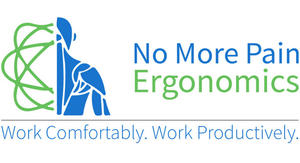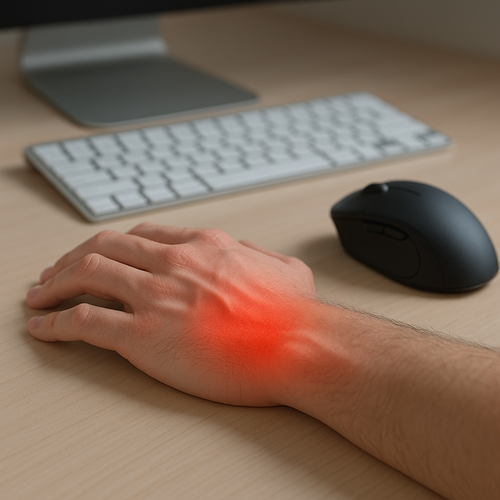If you have landed on this blog post, it may be because you are either trying to prevent a workplace injury, or find a way to reduce the pain you are already experiencing from using your keyboard at your office desk.
This blog post will be highlighting the correct positioning and techniques to help you work more comfortably and with less pain while using your computer keyboard.
The steps to consider for the most optimal keyboard use are:
- Maintain proper posture.
- Set up your workstation correctly.
- Use an ergonomic keyboard.
- Pay attention to the position of your hands.
- Monitor your position and typing technique.
- Stretch your muscles before and after typing.
Maintain Proper Posture
This blog post will talk specifically about the posture of your elbows and wrists while sitting or standing at your desk.
- Ensure your chair is adjusted so that your elbows are in line with the desk or slightly below
- Relaxed shoulders
- Sitting up straight, and bringing your body in as close to the desk as possible for maximum access to your desk without reaching
Correct Workstation Setup for Typing
Your keyboard should be placed:
- directly in front of you - the 'B' key should be in line with your belly button
- no further away than 12cm from the front of your desk
Use an Ergonomic Keyboard
The gold standard for ergonomic keyboard to support your typing should be:
- flat - no raised feet at the back of the keyboard
- low profile keys - this allows soft touch typing (and arguably faster typing speed!)
- If you are broad in stature, using a split keyboard may be the perfect solution to maintain a straight, neutral forearm, wrist and hand position.
Hand Position
One of the first lessons they teach when you learn to play a piano is to keep your wrists level with your hands and higher than the level of the piano keys - typing on a keyboard is no different. This promotes a neutral wrist position that places less pressure on the carpal tunnel.
Julia Hillen
Occupational Therapist, No More Pain Ergonomics
To prevent too much pressure on the carpal tunnel, your wrists should be raised to hand level while typing.
Try to align your forearm, wrist and hand to be in a straight, neutral position while you type.
Notice the way you type with your fingers. Press gently down on the keys.
TOP TIP: Use a gel wrist support for resting between typing tasks, not resting your wrists while you type.
Stretches
Before and after a typing tasks, try some simple movements to relax and stretch your hands ready for the next task. The below video shows some example movements to try.
















← Older Post Newer Post →
0 comments
Get in Touch
Still have a question or simply want to discuss what ergonomic products are best suited? Get in touch, our expert team is available to provide free advice and support.